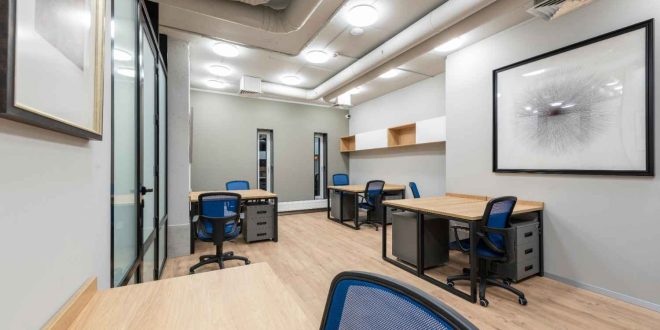In modern commercial office design, lighting plays a pivotal role in promoting productivity, creativity, and overall well-being. Natural daylight is a key component of workplace comfort, offering numerous benefits for employees. Studies have shown that exposure to natural light can improve mood, increase energy levels, and even enhance cognitive performance. However, balancing the influx of daylight with the need to reduce glare is a significant challenge for an interior design firm when coming up with an office design concept.
This article will explore practical solutions to create bright office spaces that harness the power of natural light while minimizing the disruptive effects of glare.
The Benefits of Natural Daylight in the Workplace
Before diving into the solutions, it’s important to understand why natural daylight is so beneficial. Here are some of the primary advantages:
- Improved Productivity: Studies by the World Green Building Council have demonstrated that employees working in offices with ample natural light are 18% more productive. This is linked to the fact that natural light helps regulate the body’s circadian rhythm, reducing fatigue.
- Better Mood and Wellbeing: Exposure to sunlight boosts serotonin levels, a hormone that stabilizes mood and happiness. Workers in naturally lit environments are less prone to stress and anxiety compared to those in windowless offices.
- Energy Efficiency: Incorporating natural light can significantly reduce the reliance on artificial lighting, resulting in lower energy consumption and cost savings for businesses.
Despite these advantages, poorly managed daylight can also create issues, particularly in the form of glare and excessive heat.
Challenges with Daylight and Glare
Glare occurs when there is too much contrast between bright light and shadows or when light reflects off surfaces like computer screens or glossy furniture. This can cause eye strain, headaches, and discomfort, leading to a drop in productivity. In some cases, too much sunlight can also increase indoor temperatures, forcing higher air conditioning costs.
Balancing daylight with the need to reduce glare requires careful planning and the use of innovative design solutions. Let’s explore these.
Effective Solutions for Maximizing Daylight and Reducing Glare
- Smart Window Placement and Orientation
One of the most fundamental aspects of designing a bright yet glare-free office is the strategic placement of windows. South-facing windows tend to bring in the most daylight throughout the day, but they are also prone to causing glare and excessive heat gain. East and west-facing windows receive direct sunlight in the morning and evening, respectively, which can also be problematic.
Solution: Opt for north-facing windows, as they provide consistent, indirect natural light without harsh glare. If south-facing windows are unavoidable, using high-performance glazing materials that reduce heat and glare while allowing natural light to filter in can help. Additionally, designing workstations so they are not directly facing windows can minimize discomfort. - Window Treatments: Blinds, Shades, and Films
One of the most straightforward solutions to managing natural light and reducing glare is installing adjustable window treatments.
Solution: Consider roller shades, venetian blinds, or light-diffusing window films. These solutions offer flexibility in controlling the amount of sunlight entering the office. For instance, adjustable blinds can be tilted to direct light towards the ceiling, creating an even distribution of light without harsh reflections.
Solar shades, in particular, are popular in modern offices as they reduce glare and heat while maintaining outside views. These treatments also come in a range of openness factors, allowing companies to customize based on their specific needs. - Use of Reflective and Light-Diffusing Surfaces
Reflective surfaces can be both a blessing and a curse. When used appropriately, they can help distribute light evenly across the office, brightening up darker areas. However, they can also exacerbate glare if not carefully managed.
Solution: Opt for matte finishes and light-diffusing materials for desks, floors, and other surfaces. Light-colored walls and ceilings can reflect natural light deeper into the space without creating the harsh contrasts that cause glare. Additionally, installing light shelves—horizontal surfaces that reflect daylight onto ceilings and into the office—can help spread light evenly while reducing the need for artificial lighting. - Integrating Skylights and Light Wells
Skylights and light wells are excellent options for offices that might not have access to enough window space. These architectural features channel daylight from the roof directly into the office, offering a natural and pleasant light source.
Solution: When installing skylights, choose glazing materials with low solar heat gain coefficients (SHGC) to reduce heat buildup. Additionally, consider using diffusers that spread light evenly throughout the space. For multi-story buildings, light wells can be integrated into the central design to bring daylight from the top floor down to lower levels. - Task Lighting for Workspace Flexibility
While natural light is ideal for most areas of the office, not all tasks benefit from bright ambient lighting. For detailed or focused work, such as reading or screen-based tasks, excessive light can be counterproductive.
Solution: Provide employees with task lighting options. This can include adjustable desk lamps or under-cabinet lighting that allows individuals to control the light intensity in their personal workspace. By offering localized lighting solutions, the general office environment can remain bright without causing discomfort for specific tasks. - Dynamic Glazing and Smart Windows
The advent of smart technology has revolutionized office lighting. Dynamic glazing or smart windows automatically adjust their tint based on the intensity of sunlight. This not only reduces glare and heat but also ensures optimal daylight throughout the day.
Solution: Install smart windows that use electrochromic technology to transition between clear and tinted states. These windows can be programmed to adjust automatically based on the sun’s position, ensuring maximum comfort while reducing energy costs associated with air conditioning and artificial lighting. - Biophilic Design to Enhance Natural Light
Biophilic design—a concept that integrates natural elements into indoor environments—can also improve lighting conditions in offices. Incorporating plants, natural materials, and textures can reduce the perceived harshness of light and create a more comfortable atmosphere.
Solution: Combine plants with reflective surfaces or light shelves to soften the intensity of daylight and reduce glare. Vertical gardens or indoor planters can serve as natural diffusers, breaking up direct sunlight and preventing harsh reflections on desks and screens.
Conclusion: Achieving the Perfect Balance
Creating a bright, comfortable office space that maximizes daylight while minimizing glare often benefits from the expertise of an interior design firm. These professionals ensure a balanced approach by implementing smart window placement, adjustable treatments, reflective surfaces, and advanced technologies like smart windows, all tailored to the specific needs of the workspace.
In addition to enhancing productivity, these solutions—designed by experts—promote sustainability by reducing reliance on artificial lighting and HVAC systems. The result is a visually appealing office that fosters employee health, wellbeing, and overall satisfaction.
 Diverse Perspectives: Insights & Stories Exploring Ideas, Sharing Knowledge
Diverse Perspectives: Insights & Stories Exploring Ideas, Sharing Knowledge





